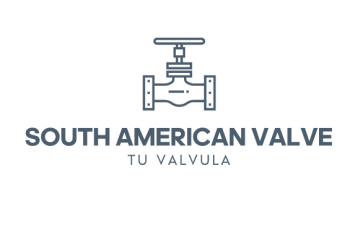Gate Valve
South American valve is the largest Gate Valve Manufacturer in Mexico . A gate valve is a type of valve that controls the flow of fluid or gas by using a sliding gate or wedge that moves up and down to either block or allow flow through the valve. The gate in a gate valve can be made of a variety of materials, including metal, plastic, or rubber, and is often designed with a Levelled edge to improve sealing when the valve is closed.
Gate valves are commonly used in applications where a full bore flow is required, and they are often used in pipelines that transport fluids or gases under high pressure. They are also used in applications where the valve needs to be fully open or fully closed, rather than partially open or partially closed.
One advantage of gate valves is that they offer a relatively low pressure drop, meaning they do not restrict the flow of fluid or gas as it moves through the system. However, gate valves can be slower to open and close than other types of valves, and they are not suitable for regulating flow or controlling pressure.
Gate valves are commonly used in a variety of applications, including oil and gas pipelines, water treatment plants, and industrial processes. They are often used in situations where a large volume of fluid or gas needs to be moved quickly, and where the valve needs to be able to fully shut off flow to prevent leaks or spills.
Types
- Rising Stem Gate Valve
- Non-Rising Stem Gate Valve
- Bellow Seal Gate Valve
- Pressure Seal Gate Valve
- Cryogenic Gate Valve
- Forged Gate Valve
Applications
- Oil and gas pipelines: Gate valves are commonly used in oil and gas pipelines to control the flow of crude oil, natural gas, or other fluids under high pressure.
- Water treatment plants: Gate valves are used in water treatment plants to control the flow of water through different stages of the treatment process.
- Power generation: Gate valves are used in power generation plants to control the flow of steam or water in turbines and other equipment.
- Chemical and petrochemical industries: Gate valves are used in chemical and petrochemical plants to control the flow of various chemicals and gases in different processes.
- Mining: Gate valves are used in mining operations to control the flow of water, slurries, or other fluids in the processing of minerals.
- HVAC systems: Gate valves are used in heating, ventilation, and air conditioning (HVAC) systems to control the flow of water in heating and cooling systems.
- Marine and offshore: Gate valves are used in marine and offshore applications, such as oil rigs and ships, to control the flow of fluids and gases.
Advantages
- Full bore flow: Gate valves offer a full-bore flow path, which means that there is little resistance to flow, resulting in minimal pressure drop.
- Strong and durable: Gate valves are designed to withstand high pressure and temperatures, making them ideal for use in demanding industrial applications.
- Tight seal: The gate valve’s gate or wedge design allows for a tight seal when the valve is fully closed, which helps prevent leaks and reduces the risk of contamination.
- Easy to operate: Gate valves are relatively easy to operate, typically requiring only a quarter-turn to fully open or close.
- Long service life: Gate valves are constructed with high-quality materials and are designed for long service life
- with minimal maintenance.
- Versatile: Gate valves can be used in a wide range of applications across various industries.
Difference between Gate valve and Globe Valve –
- Design: Globe valves have a globe-shaped body with a movable disk or plug that moves up and down to control the flow of fluid. In contrast, gate valves have a gate-shaped disk or wedge that moves perpendicular to the flow of fluid to control the flow.
- Flow control: Globe valves are designed to regulate flow and provide accurate control over the flow rate. They can be used to partially open or close the valve to regulate the flow of fluid. Gate valves, on the other hand, are designed for full flow or no flow applications. They are used to either fully open or fully close the valve.
- Pressure drop: Globe valves are known to cause a higher pressure drop than gate valves, due to the turbulence created by the disk or plug. Gate valves have a relatively low pressure drop, as they provide an unobstructed flow path.
- Application: Globe valves are commonly used in applications where precise control over the flow rate is required, such as in the oil and gas industry, chemical processing plants, and water treatment facilities. Gate valves are often used in applications where a full bore flow is required, such as in pipelines that transport fluids or gases under high pressure.
- Size and cost: Globe valves are available in smaller sizes and are typically more expensive than gate valves. Gate valves are available in larger sizes and are generally less expensive than globe valves.
Description
- Available materials: Ductile Iron,SS306, SS904, SS316, Aluminum Bronze, Monel, Bronze, Brass, Duplex steel, Inconel, Incoloy, Titanium, CF8, CF8M, CF3, CF3M, WC1, Cast iron Carbon steel(WCB, WCC,WC6, LCB, LF2, WC9
- Size: 1/2″- 64”
- Class: 150 to 2500
- Nominal Pressure: PN10 to PN450
- Operations: Hand Wheel, Gear operated, Electric and Pneumatic, Actuated
- Ends: Flanged, Buttweld, Socket weld, Threaded
- Standards: ASME, API6D, API607, DIN, BS, ANSI, AWWA
Double Disc Gate Valve
Gate Valve
Gate Valve
Gate Valve
Gate Valve
Gate Valve
Gate Valve
Gate Valve
Gate Valve
Gate Valve
Gate Valve






















